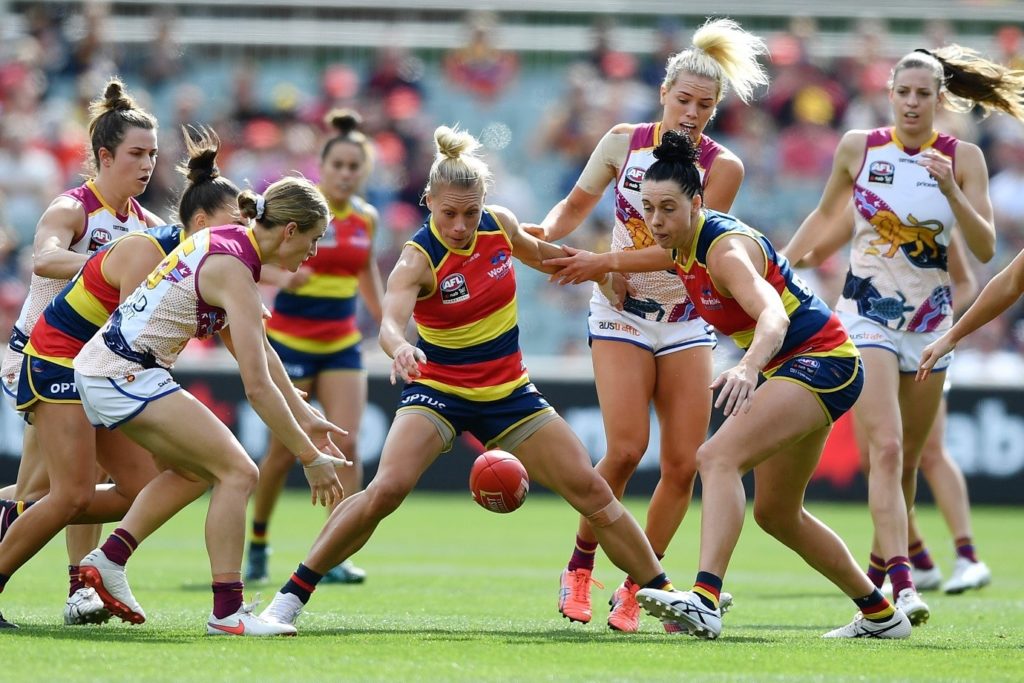The AFLW has made huge leaps since its start in 2017, with the game looking to achieve equal participation and representation for girls and women by the end of this decade.
In 2018, the overall number of women and girls playing AFLW was one-third of the national football participation and since 2021, more than half a million girls and women are now playing the game.
The fan base for AFLW is also immense with matches like the inaugural face off between Essendon and Hawthorn selling out their venue within a day and being moved to the much larger Marvel Stadium.
Sellouts like this highlight just how much support for women’s footy is growing as AFLW enters its seventh season, with the first game kicking off on Thursday night.
The History
The Australian Football League (AFL) got its start for men all the way back in 1858 when the rules were first written.
From the early 20th century, AFL clubs hosted occasional female round-robin tournaments and matches, while female players developed their own local and regional amateur competitions.
It wasn’t until 2010, however, that the AFL commissioned a review of women’s football in Australia and recommended a professional national women’s competition be developed in 2020.
The support surrounding the idea of the AFLW brought the league into fruition a whole three years earlier, in 2017, and hasn’t waned since.
The first premiership AFLW game occurred at Ikon Park in Melbourne, Victoria on February 3, 2017 between the Collingwood Magpies and the Carlton Blues. The inaugural season included eight teams: Carlton, Collingwood, Melbourne, Western Bulldogs, Fremantle, Adelaide Crows, Greater Western Sydney Giants and Brisbane Lions.
By its sixth season, AFLW had become the single biggest employer of professional sports for women in the country with 420 players.
AFLW has also grown to become the most supported women’s league in Australia, with 7.3 million Australians having some level of interest in the women’s competition.
Season 7
Coming into its seventh season, AFLW is making more impact than ever before. The league has made history by bringing in Hawthorn, the Sydney Swans, Port Adelaide and Essendon to complete its competition with all 18 clubs represented.
The season opener will kick things off at Ikon Park on August 25 between Carlton and Collingwood– a start date that’s been moved up from the usual November season opening.
What follows is fourteen weeks of football with 10 home-and-away rounds plus four weeks of finals.
The season length has been a point of contempt with some saying they want a season where each side plays each other. Hawthorn captain Tilly Lucas-Rodd says they see it as fair to the game and the athletes to play everyone once which is why they’re pushing for negotiations at the players’ association.
Another negotiation panned out earlier in the year for AFLW players who were fighting to close the gender pay gap. A pay rise of an average of 94% across all four payment tiers was secured, meaning some of the players are able to focus solely on their football season without needing to make financial ends meet with conflicting work obligations.
As for the outcome of the upcoming season, Captain favourites for the flag include Melbourne and the Brisbane Lions, followed by the reigning premiers Adelaide and Fremantle.
Inspiring the next generation of women
An increasing number of girls are taking up footy and the AFLW is often praised for inspiring the next generation of female athletes.
Since 2021, the league has reported that across Australia, there are now 12.4 female football players for every 1 player in 2010. AFLW also reports there are 2,540 girls’ and womens’ community football teams with around 69,829 players.
The mission of the AFLW remains to accelerate the growth in women’s football economy and to create greater opportunities on and off the field for the best of their women players and administrators.
All around Australia, young girls and women in their 20s, 30s and 40s are inspired by the AFLW to join the sport, both socially and competitively, in their local clubs.
It took over 150 years for a women’s footy competition to develop from the AFL and now that the seventh season is here, its impact is only growing.


